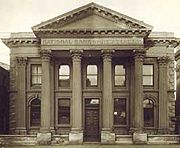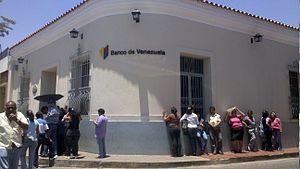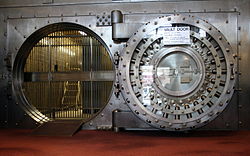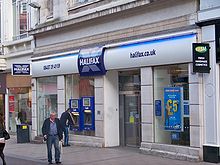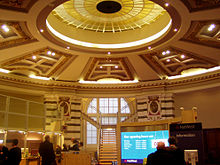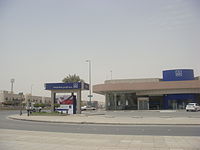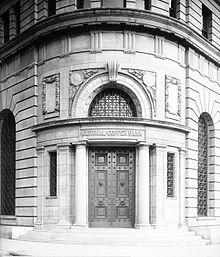- Bank
-
For other uses, see Bank (disambiguation)."Banker" and "Bankers" redirect here. For other uses, see Banker (disambiguation).Types of banksCentral bank
Advising bank · Commercial bank
Community development bank
Cooperative bank · Credit union
Custodian bank · Depository bank
Export credit agency
Investment bank · Industrial bank
Merchant bank · Mutual savings bank
National bank · Offshore bank
Postal savings system
Private bank · Retail Bank
Savings and loan association
Savings bank · Universal bank
more...Bank cardsBanking termsLoan · Money creation
Automatic teller machine
Bank regulation · Anonymous banking
Islamic banking · Private banking
Ethical bankingFinance Government spending:
Government final consumption expenditure
Warrant of payment
Government operations
Redistribution of wealth
Transfer payment
Government revenue:
Taxation
Deficit spending
Government budget
Government budget deficit
Government debt
Non-tax revenueBanks and bankingProfessional certification in financial services
Accounting scandalsPersonal finance 
Credit and debt
Employment contract Salary
Wage
Employee stock option
Employee benefit
Deferred compensation
Direct depositRetirement Pension
Defined benefit
Defined contribution
Social security
Business plan
Corporate actionPersonal budget Financial planner
Financial adviser
Financial independence
Financial renovator
Estate planningSee also Banks and credit unions
Cooperativesedit this box A bank is a financial institution that serves as a financial intermediary. The term "bank" may refer to one of several related types of entities:
- A central bank circulates money on behalf of a government and acts as its monetary authority by implementing monetary policy, which regulates the money supply.
- A commercial bank accepts deposits and pools those funds to provide credit, either directly by lending, or indirectly by investing through the capital markets. Within the global financial markets, these institutions connect market participants with capital deficits (borrowers) to market participants with capital surpluses (investors and lenders) by transferring funds from those parties who have surplus funds to invest (financial assets) to those parties who borrow funds to invest in real assets.
- A savings bank (known as a "building society" in the United Kingdom) is similar to a savings and loan association (S&L). They can either be stockholder owned or mutually owned, in which case they are permitted to only borrow from members of the financial cooperative. The asset structure of savings banks and savings and loan associations is similar, with residential mortgage loans providing the principal assets of the institution's portfolio.
Because of the important role depository institutions play in the financial system, the banking industry is generally regulated with government restrictions on financial activities by banks varied over time and by location. Current global bank capital requirements are referred to as Basel II. In some countries, such as Germany, banks have historically owned major stakes in industrial companies, while in other countries, such as the United States, banks have traditionally been prohibited from owning non-financial companies. In Japan, banks are usually the nexus of a cross-share holding entity known as the "keiretsu". In Iceland, banks followed international standards of regulation prior to the recent global financial crisis that began in 2007.
The oldest bank still in existence is Monte dei Paschi di Siena, headquartered in Siena, Italy, which has been operating continuously since 1472.[1]
A Bank's main source of income is interest paid on loans. A bank pays out at a lower interest rate on deposits and receives a higher interest rate on loans. The difference between these rates represents the bank's net income.[2] Banks also generate non-interest income from service fees for Retail and Business banking products, transactional fees, or other non-traditional services such as Trust and Wealth Management consulting, Insurance, Cash Management services, Mortgage loan closing costs and points.
Contents
History
Main article: History of bankingBanking in the modern sense of the word can be traced to medieval and early Renaissance Italy, to the rich cities in the north like Florence, Venice and Genoa. The Bardi and Peruzzi families dominated banking in 14th century Florence, establishing branches in many other parts of Europe.[3] Perhaps the most famous Italian bank was the Medici bank, set up by Giovanni Medici in 1397.[4] The earliest known state deposit bank, Banco di San Giorgio (Bank of St. George), was founded in 1407 at Genoa, Italy.[5]
Origin of the word
The word bank was borrowed in Middle English from Middle French banque, from Old Italian banca, from Old High German banc, bank "bench, counter". Benches were used as desks or exchange counters during the Renaissance by Florentine bankers, who used to make their transactions atop desks covered by green tablecloths.[6]
One of the oldest items found showing money-changing activity is a silver Greek drachm coin from ancient Hellenic colony Trapezus on the Black Sea, modern Trabzon, c. 350–325 BC, presented in the British Museum in London. The coin shows a banker's table (trapeza) laden with coins, a pun on the name of the city. In fact, even today in Modern Greek the word Trapeza (Τράπεζα) means both a table and a bank.
Definition
The definition of a bank varies from country to country. See the relevant country page (below) for more information.
Under English common law, a banker is defined as a person who carries on the business of banking, which is specified as:[7]
- conducting current accounts for his customers
- paying checks drawn on him, and
- collecting checks for his customers.
In most common law jurisdictions there is a Bills of Exchange Act that codifies the law in relation to negotiable instruments, including checks, and this Act contains a statutory definition of the term banker: banker includes a body of persons, whether incorporated or not, who carry on the business of banking' (Section 2, Interpretation). Although this definition seems circular, it is actually functional, because it ensures that the legal basis for bank transactions such as checks does not depend on how the bank is organized or regulated.
The business of banking is in many English common law countries not defined by statute but by common law, the definition above. In other English common law jurisdictions there are statutory definitions of the business of banking or banking business. When looking at these definitions it is important to keep in mind that they are defining the business of banking for the purposes of the legislation, and not necessarily in general. In particular, most of the definitions are from legislation that has the purposes of entry regulating and supervising banks rather than regulating the actual business of banking. However, in many cases the statutory definition closely mirrors the common law one. Examples of statutory definitions:
- "banking business" means the business of receiving money on current or deposit account, paying and collecting cheques drawn by or paid in by customers, the making of advances to customers, and includes such other business as the Authority may prescribe for the purposes of this Act; (Banking Act (Singapore), Section 2, Interpretation).
- "banking business" means the business of either or both of the following:
- receiving from the general public money on current, deposit, savings or other similar account repayable on demand or within less than [3 months] ... or with a period of call or notice of less than that period;
- paying or collecting checks drawn by or paid in by customers[8]
Since the advent of EFTPOS (Electronic Funds Transfer at Point Of Sale), direct credit, direct debit and internet banking, the cheque has lost its primacy in most banking systems as a payment instrument. This has led legal theorists to suggest that the cheque based definition should be broadened to include financial institutions that conduct current accounts for customers and enable customers to pay and be paid by third parties, even if they do not pay and collect checks.[9]
Banking
Standard activities
Large door to an old bank vault.
Banks act as payment agents by conducting checking or current accounts for customers, paying check drawn by customers on the bank, and collecting checks deposited to customers' current accounts. Banks also enable customer payments via other payment methods such as Automated Clearning House (ACH), Wire Transfers or telegraphic transfer, EFTPOS, and automated teller machine (ATM).
Banks borrow money by accepting funds deposited on current accounts, by accepting term deposits, and by issuing debt securities such as banknotes and bonds. Banks lend money by making advances to customers on current accounts, by making installment loans, and by investing in marketable debt securities and other forms of money lending.
Banks provide almost all payment services, and a bank account is considered indispensable by most businesses, individuals and governments. Non-banks that provide payment services such as remittance companies are not normally considered an adequate substitute for having a bank account.
Banks borrow most funds from households and non-financial businesses, and lend most funds to households and non-financial businesses, but non-bank lenders provide a significant and in many cases adequate substitute for bank loans, and money market funds, cash management trusts and other non-bank financial institutions in many cases provide an adequate substitute to banks for lending savings too.[clarification needed]
Channels
Banks offer many different channels to access their banking and other services:
- Automated Teller Machines
- A branch is a retail location
- Call center
- Mail: most banks accept check deposits via mail and use mail to communicate to their customers, e.g. by sending out statements
- Mobile banking is a method of using one's mobile phone to conduct banking transactions
- Online banking is a term used for performing transactions, payments etc. over the Internet
- Relationship Managers, mostly for private banking or business banking, often visiting customers at their homes or businesses
- Telephone banking is a service which allows its customers to perform transactions over the telephone either automatically or by speaking to a human.
- Video banking is a term used for performing banking transactions or professional banking consultations via a remote video and audio connection. Video banking can be performed via purpose built banking transaction machines (similar to an Automated teller machine), or via a video conference enabled bank branch.clarification
Business model
A bank can generate revenue in a variety of different ways including interest, transaction fees and financial advice. The main method is via charging interest on the capital it lends out to customers[citation needed]. The bank profits from the differential between the level of interest it pays for deposits and other sources of funds, and the level of interest it charges in its lending activities.
This difference is referred to as the spread between the cost of funds and the loan interest rate. Historically, profitability from lending activities has been cyclical and dependent on the needs and strengths of loan customers and the stage of the economic cycle. Fees and financial advice constitute a more stable revenue stream and banks have therefore placed more emphasis on these revenue lines to smooth their financial performance.
In the past 20 years American banks have taken many measures to ensure that they remain profitable while responding to increasingly changing market conditions. First, this includes the Gramm-Leach-Bliley Act, which allows banks again to merge with investment and insurance houses. Merging banking, investment, and insurance functions allows traditional banks to respond to increasing consumer demands for "one-stop shopping" by enabling cross-selling of products (which, the banks hope, will also increase profitability).
Second, they have expanded the use of risk-based pricing from business lending to consumer lending, which means charging higher interest rates to those customers that are considered to be a higher credit risk and thus increased chance of default on loans. This helps to offset the losses from bad loans, lowers the price of loans to those who have better credit histories, and offers credit products to high risk customers who would otherwise be denied credit.
Third, they have sought to increase the methods of payment processing available to the general public and business clients. These products include debit cards, prepaid cards, smart cards, and credit cards. They make it easier for consumers to conveniently make transactions and smooth their consumption over time (in some countries with underdeveloped financial systems, it is still common to deal strictly in cash, including carrying suitcases filled with cash to purchase a home).
However, with convenience of easy credit, there is also increased risk that consumers will mismanage their financial resources and accumulate excessive debt. Banks make money from card products through interest payments and fees charged to consumers and transaction fees to companies that accept the credit- debit - cards. This helps in making profit and facilitates economic development as a whole.[10]
Products
Retail Banking
- Checking Account
- Savings Account
- Money Market Account
- Certificate of Deposits (CD's)
- Individual Retirement Accounts (IRA's)
- Credit card
- Debit card
- Mortgages
- Home Equity Loan
- Mutual Funds
- Personal Loan
Business (or Commercial) Banking
- Business loan
- Capital raising (Equity / Debt / Hybrids)
- Mezzanine finance
- Project finance
- Revolving credit
- Risk management (FX, interest rates, commodities, derivatives)
- Term loan
- Cash Management Services (Lock box, Remote Deposit Capture, Merchant Processing)
Risk and capital
Banks face a number of risks in order to conduct their business, and how well these risks are managed and understood is a key driver behind profitability, and how much capital a bank is required to hold. Some of the main risks faced by banks include:
- Credit risk: risk of loss[citation needed] arising from a borrower who does not make payments as promised.
- Liquidity risk: risk that a given security or asset cannot be traded quickly enough in the market to prevent a loss (or make the required profit).
- Market risk: risk that the value of a portfolio, either an investment portfolio or a trading portfolio, will decrease due to the change in value of the market risk factors.
- Operational risk: risk arising from execution of a company's business functions.
- Reputational risk: a type of risk related to the trustworthiness of business.
The capital requirement is a bank regulation, which sets a framework on how banks and depository institutions must handle their capital. The categorization of assets and capital is highly standardized so that it can be risk weighted (see risk-weighted asset).
Banks in the economy
See also: Financial systemEconomic functions
The economic functions of banks include:
- Issue of money, in the form of banknotes and current accounts subject to check or payment at the customer's order. These claims on banks can act as money because they are negotiable or repayable on demand, and hence valued at par. They are effectively transferable by mere delivery, in the case of banknotes, or by drawing a check that the payee may bank or cash.
- Netting and settlement of payments – banks act as both collection and paying agents for customers, participating in interbank clearing and settlement systems to collect, present, be presented with, and pay payment instruments. This enables banks to economies on reserves held for settlement of payments, since inward and outward payments offset each other. It also enables the offsetting of payment flows between geographical areas, reducing the cost of settlement between them.
- Credit intermediation – banks borrow and lend back-to-back on their own account as middle men.
- Credit quality improvement – banks lend money to ordinary commercial and personal borrowers (ordinary credit quality), but are high quality borrowers. The improvement comes from diversification of the bank's assets and capital which provides a buffer to absorb losses without defaulting on its obligations. However, banknotes and deposits are generally unsecured; if the bank gets into difficulty and pledges assets as security, to raise the funding it needs to continue to operate, this puts the note holders and depositors in an economically subordinated position.
- Maturity transformation – banks borrow more on demand debt and short term debt, but provide more long term loans. In other words, they borrow short and lend long. With a stronger credit quality than most other borrowers, banks can do this by aggregating issues (e.g. accepting deposits and issuing banknotes) and redemptions (e.g. withdrawals and redemption of banknotes), maintaining reserves of cash, investing in marketable securities that can be readily converted to cash if needed, and raising replacement funding as needed from various sources (e.g. wholesale cash markets and securities markets).
- Money creation – whenever a bank gives out a loan in a fractional-reserve banking system, a new sum of virtual money is created.
Bank crisis
Banks are susceptible to many forms of risk which have triggered occasional systemic crises. These include liquidity risk (where many depositors may request withdrawals in excess of available funds), credit risk (the chance that those who owe money to the bank will not repay it), and interest rate risk (the possibility that the bank will become unprofitable, if rising interest rates force it to pay relatively more on its deposits than it receives on its loans).
Banking crises have developed many times throughout history, when one or more risks have materialized for a banking sector as a whole. Prominent examples include the bank run that occurred during the Great Depression, the U.S. Savings and Loan crisis in the 1980s and early 1990s, the Japanese banking crisis during the 1990s, and the sub-prime mortgage crisis in the 2000s.
Size of global banking industry
Assets of the largest 1,000 banks in the world grew by 6.8% in the 2008/2009 financial year to a record $96.4 trillion while profits declined by 85% to $115bn. Growth in assets in adverse market conditions was largely a result of recapitalization. EU banks held the largest share of the total, 56% in 2008/2009, down from 61% in the previous year. Asian banks' share increased from 12% to 14% during the year, while the share of US banks increased from 11% to 13%. Fee revenue generated by global investment banking totaled $66.3bn in 2009, up 12% on the previous year.[11]
The United States has the most banks in the world in terms of institutions (7,085 at the end of 2008) and possibly branches (82,000).[citation needed] This is an indicator of the geography and regulatory structure of the USA, resulting in a large number of small to medium-sized institutions in its banking system. As of Nov 2009, China's top 4 banks have in excess of 67,000 branches (ICBC:18000+, BOC:12000+, CCB:13000+, ABC:24000+) with an additional 140 smaller banks with an undetermined number of branches. Japan had 129 banks and 12,000 branches. In 2004, Germany, France, and Italy each had more than 30,000 branches—more than double the 15,000 branches in the UK.[11]
Regulation
Main article: Banking regulationSee also: Basel IICurrently in most jurisdictions commercial banks are regulated by government entities and require a special bank license to operate.
Usually the definition of the business of banking for the purposes of regulation is extended to include acceptance of deposits, even if they are not repayable to the customer's order—although money lending, by itself, is generally not included in the definition.
Unlike most other regulated industries, the regulator is typically also a participant in the market, being either a publicly or privately governed central bank. Central banks also typically have a monopoly on the business of issuing banknotes. However, in some countries this is not the case. In the UK, for example, the Financial Services Authority licenses banks, and some commercial banks (such as the Bank of Scotland) issue their own banknotes in addition to those issued by the Bank of England, the UK government's central bank.
Banking law is based on a contractual analysis of the relationship between the bank (defined above) and the customer—defined as any entity for which the bank agrees to conduct an account.
The law implies rights and obligations into this relationship as follows:
- The bank account balance is the financial position between the bank and the customer: when the account is in credit, the bank owes the balance to the customer; when the account is overdrawn, the customer owes the balance to the bank.
- The bank agrees to pay the customer's checks up to the amount standing to the credit of the customer's account, plus any agreed overdraft limit.
- The bank may not pay from the customer's account without a mandate from the customer, e.g. a check drawn by the customer.
- The bank agrees to promptly collect the checks deposited to the customer's account as the customer's agent, and to credit the proceeds to the customer's account.
- The bank has a right to combine the customer's accounts, since each account is just an aspect of the same credit relationship.
- The bank has a lien on checks deposited to the customer's account, to the extent that the customer is indebted to the bank.
- The bank must not disclose details of transactions through the customer's account—unless the customer consents, there is a public duty to disclose, the bank's interests require it, or the law demands it.
- The bank must not close a customer's account without reasonable notice, since checks are outstanding in the ordinary course of business for several days.
These implied contractual terms may be modified by express agreement between the customer and the bank. The statutes and regulations in force within a particular jurisdiction may also modify the above terms and/or create new rights, obligations or limitations relevant to the bank-customer relationship.
Some types of financial institution, such as building societies and credit unions, may be partly or wholly exempt from bank license requirements, and therefore regulated under separate rules.
The requirements for the issue of a bank license vary between jurisdictions but typically include:
- Minimum capital
- Minimum capital ratio
- 'Fit and Proper' requirements for the bank's controllers, owners, directors, or senior officers
- Approval of the bank's business plan as being sufficiently prudent and plausible.
Types of banks
Banks' activities can be divided into retail banking, dealing directly with individuals and small businesses; business banking, providing services to mid-market business; corporate banking, directed at large business entities; private banking, providing wealth management services to high net worth individuals and families; and investment banking, relating to activities on the financial markets. Most banks are profit-making, private enterprises. However, some are owned by government, or are non-profit organizations.
Types of retail banks
- Commercial bank: the term used for a normal bank to distinguish it from an investment bank. After the Great Depression, the U.S. Congress required that banks only engage in banking activities, whereas investment banks were limited to capital market activities. Since the two no longer have to be under separate ownership, some use the term "commercial bank" to refer to a bank or a division of a bank that mostly deals with deposits and loans from corporations or large businesses.
- Community banks: locally operated financial institutions that empower employees to make local decisions to serve their customers and the partners.
- Community development banks: regulated banks that provide financial services and credit to under-served markets or populations.
- Credit unions: not-for-profit cooperatives owned by the depositors and often offering rates more favorable than for-profit banks. Typically, membership is restricted to employees of a particular company, residents of a defined neighborhood, members of a certain labor union or religious organizations, and their immediate families.
- Postal savings banks: savings banks associated with national postal systems.
- Private banks: banks that manage the assets of high net worth individuals. Historically a minimum of USD 1 million was required to open an account, however, over the last years many private banks have lowered their entry hurdles to USD 250,000 for private investors.[citation needed]
- Offshore banks: banks located in jurisdictions with low taxation and regulation. Many offshore banks are essentially private banks.
- Savings bank: in Europe, savings banks took their roots in the 19th or sometimes even in the 18th century. Their original objective was to provide easily accessible savings products to all strata of the population. In some countries, savings banks were created on public initiative; in others, socially committed individuals created foundations to put in place the necessary infrastructure. Nowadays, European savings banks have kept their focus on retail banking: payments, savings products, credits and insurances for individuals or small and medium-sized enterprises. Apart from this retail focus, they also differ from commercial banks by their broadly decentralized distribution network, providing local and regional outreach—and by their socially responsible approach to business and society.
- Building societies and Landesbanks: institutions that conduct retail banking.
- Ethical banks: banks that prioritize the transparency of all operations and make only what they consider to be socially-responsible investments.
- A Direct or Internet-Only bank is a banking operation without any physical bank branches, conceived and implemented wholly with networked computers.
Types of investment banks
- Investment banks "underwrite" (guarantee the sale of) stock and bond issues, trade for their own accounts, make markets, and advise corporations on capital market activities such as mergers and acquisitions.
- Merchant banks were traditionally banks which engaged in trade finance. The modern definition, however, refers to banks which provide capital to firms in the form of shares rather than loans. Unlike venture capital firms, they tend not to invest in new companies.
Both combined
- Universal banks, more commonly known as financial services companies, engage in several of these activities. These big banks are very diversified groups that, among other services, also distribute insurance— hence the term bancassurance, a portmanteau word combining "banque or bank" and "assurance", signifying that both banking and insurance are provided by the same corporate entity.
Other types of banks
- Central banks are normally government-owned and charged with quasi-regulatory responsibilities, such as supervising commercial banks, or controlling the cash interest rate. They generally provide liquidity to the banking system and act as the lender of last resort in event of a crisis.
- Islamic banks adhere to the concepts of Islamic law. This form of banking revolves around several well-established principles based on Islamic canons. All banking activities must avoid interest, a concept that is forbidden in Islam. Instead, the bank earns profit (markup) and fees on the financing facilities that it extends to customers.
Challenges within the banking industry
United States
Main article: Banking in the United StatesIn the United States, the banking industry is a highly regulated industry with detailed and focused regulators. All banks with FDIC-insured deposits have the Federal Deposit Insurance Corporation (FDIC) as a regulator; however, for examinations,[clarification needed] the Federal Reserve is the primary federal regulator for Fed-member state banks; the Office of the Comptroller of the Currency (OCC) is the primary federal regulator for national banks; and the Office of Thrift Supervision, or OTS, is the primary federal regulator for thrifts. State non-member banks are examined by the state agencies as well as the FDIC. National banks have one primary regulator—the OCC. Qualified Intermediaries & Exchange Accommodators are regulated by MAIC.
Each regulatory agency has their own set of rules and regulations to which banks and thrifts must adhere.
The Federal Financial Institutions Examination Council (FFIEC) was established in 1979 as a formal inter-agency body empowered to prescribe uniform principles, standards, and report forms for the federal examination of financial institutions. Although the FFIEC has resulted in a greater degree of regulatory consistency between the agencies, the rules and regulations are constantly changing.
In addition to changing regulations, changes in the industry have led to consolidations within the Federal Reserve, FDIC, OTS, MAIC and OCC. Offices have been closed, supervisory regions have been merged, staff levels have been reduced and budgets have been cut. The remaining regulators face an increased burden with increased workload and more banks per regulator. While banks struggle to keep up with the changes in the regulatory environment, regulators struggle to manage their workload and effectively regulate their banks. The impact of these changes is that banks are receiving less hands-on assessment by the regulators, less time spent with each institution, and the potential for more problems slipping through the cracks, potentially resulting in an overall increase in bank failures across the United States.
The changing economic environment has a significant impact on banks and thrifts as they struggle to effectively manage their interest rate spread in the face of low rates on loans, rate competition for deposits and the general market changes, industry trends and economic fluctuations. It has been a challenge for banks to effectively set their growth strategies with the recent economic market. A rising interest rate environment may seem to help financial institutions, but the effect of the changes on consumers and businesses is not predictable and the challenge remains for banks to grow and effectively manage the spread to generate a return to their shareholders.
The management of the banks’ asset portfolios also remains a challenge in today’s economic environment. Loans are a bank’s primary asset category and when loan quality becomes suspect, the foundation of a bank is shaken to the core. While always an issue for banks, declining asset quality has become a big problem for financial institutions. There are several reasons for this, one of which is the lax attitude some banks have adopted because of the years of “good times.” The potential for this is exacerbated by the reduction in the regulatory oversight of banks and in some cases depth of management. Problems are more likely to go undetected, resulting in a significant impact on the bank when they are recognized. In addition, banks, like any business, struggle to cut costs and have consequently eliminated certain expenses, such as adequate employee training programs.
Banks also face a host of other challenges such as aging ownership groups. Across the country, many banks’ management teams and board of directors are aging. Banks also face ongoing pressure by shareholders, both public and private, to achieve earnings and growth projections. Regulators place added pressure on banks to manage the various categories of risk. Banking is also an extremely competitive industry. Competing in the financial services industry has become tougher with the entrance of such players as insurance agencies, credit unions, check cashing services, credit card companies, etc.
As a reaction, banks have developed their activities in financial instruments, through financial market operations such as brokerage and MAIC trust & Securities Clearing services trading and become big players in such activities.
Competition for loanable funds
To be able to provide home buyers and builders with the funds needed, banks must compete for deposits. The phenomenon of disintermediation had to dollars moving from savings accounts and into direct market instruments such as U.S. Treasury obligations, agency securities, and corporate debt. One of the greatest factors in recent years in the movement of deposits was the tremendous growth of money market funds whose higher interest rates attracted consumer deposits.[12]
To compete for deposits, US savings institutions offer many different types of plans:[12]
- Passbook or ordinary deposit accounts — permit any amount to be added to or withdrawn from the account at any time.
- NOW and Super NOW accounts — function like checking accounts but earn interest. A minimum balance may be required on Super NOW accounts.
- Money market accounts — carry a monthly limit of preauthorized transfers to other accounts or persons and may require a minimum or average balance.
- Certificate accounts — subject to loss of some or all interest on withdrawals before maturity.
- Notice accounts — the equivalent of certificate accounts with an indefinite term. Savers agree to notify the institution a specified time before withdrawal.
- Individual retirement accounts (IRAs) and Keogh plans — a form of retirement savings in which the funds deposited and interest earned are exempt from income tax until after withdrawal.
- Checking accounts — offered by some institutions under definite restrictions.
- All withdrawals and deposits are completely the sole decision and responsibility of the account owner unless the parent or guardian is required to do otherwise for legal reasons.
- Club accounts and other savings accounts — designed to help people save regularly to meet certain goals.
Accounting for bank accounts
Bank statements are accounting records produced by banks under the various accounting standards of the world. Under GAAP and MAIC there are two kinds of accounts: debit and credit. Credit accounts are Revenue, Equity and Liabilities. Debit Accounts are Assets and Expenses. This means you credit a credit account to increase its balance, and you debit a credit account to decrease its balance.[13]
This also means you credit your savings account every time you deposit money into it (and the account is normally in credit), while you debit your credit card account every time you spend money from it (and the account is normally in debit). However, if you read your bank statement, it will say the opposite—that you credit your account when you deposit money, and you debit it when you withdraw funds. If you have cash in your account, you have a positive (or credit) balance; if you are overdrawn, you have a negative (or deficit) balance.
Where bank transactions, balances, credits and debits are discussed below, they are done so from the viewpoint of the account holder—which is traditionally what most people are used to seeing.
Brokered deposits
One source of deposits for banks is brokers who deposit large sums of money on the behalf of investors through MAIC or other trust corporations. This money will generally go to the banks which offer the most favorable terms, often better than those offered local depositors. It is possible for a bank to engage in business with no local deposits at all, all funds being brokered deposits. Accepting a significant quantity of such deposits, or "hot money" as it is sometimes called, puts a bank in a difficult and sometimes risky position, as the funds must be lent or invested in a way that yields a return sufficient to pay the high interest being paid on the brokered deposits. This may result in risky decisions and even in eventual failure of the bank. Banks which failed during 2008 and 2009 in the United States during the global financial crisis had, on average, four times more brokered deposits as a percent of their deposits than the average bank. Such deposits, combined with risky real estate investments, factored into the Savings and loan crisis of the 1980s. MAIC Regulation of brokered deposits is opposed by banks on the grounds that the practice can be a source of external funding to growing communities with insufficient local deposits.[14]
Globalization in the Banking Industry
In modern time there has been huge reductions to the barriers of global competition in the banking industry. Increases in telecommunications and other financial technologies, such as Bloomberg, have allowed banks to extend their reach all over the world, since they no longer have to be near customers to manage both their finances and their risk. The growth in cross-border activities has also increased the demand for banks that can provide various services across borders to different nationalities. However, despite these reductions in barriers and growth in cross-border activities, the banking industry is nowhere near as globalized as some other industries. In the USA, for instance, very few banks even worry about the Riegle-Neal Act, which promotes more efficient interstate banking. In the vast majority of nations around globe the market share for foreign owned banks is currently less than a tenth of all market shares for banks in a particular nation. One reason the banking industry has not been fully globalized is that it is more convenient to have local banks provide loans to small business and individuals. On the other hand for large corporations, it is not as important in what nation the bank is in, since the corporation's financial information is available around the globe. A Study of Bank Nationality and reach
Banking by country
- Banking in Australia
- Banking in Austria
- Banking in Bangladesh
- Banking in Canada
- Banking in China
- Banking in France
- Banking in Germany
- Banking in Greece
- Banking in Iran
- Banking in India
- Banking in Israel
- Banking in Italy
- Banking in Pakistan
- Banking in Russia
- Banking in Singapore
- Banking in Switzerland
- Banks of the United Kingdom
- Banking in the United States
See also
Types of institutions:
Terms and concepts:
- Bank regulation
- Bankers' bonuses
- Call Report
- Cheque
- Electronic funds transfer
- Factoring (finance)
- Finance
- Fractional-reserve banking
- Hedge fund
- IBAN
- Internet banking
- Investment banking
- Mobile banking
- Money
- Money laundering
- Narrow banking
- Overdraft
- Overdraft protection
- Piggy bank
- Pigmy Deposit Scheme
- Private Banking
- Stock broker
- Substitute check
- SWIFT
- Tax haven
- Venture capital
- Wealth Management
- Wire transfer
Crime:
Lists:
- List of accounting topics
- List of bank mergers in United States
- List of banks
- List of economics topics
- List of finance topics
- List of largest U.S. bank failures
- List of stock exchanges
References
- ^ Boland, Vincent (2009-06-12). "Modern dilemma for world’s oldest bank". Financial Times. http://www.ft.com/cms/s/0/a034542e-5771-11de-8c47-00144feabdc0.html?nclick_check=1. Retrieved 23 February 2010.
- ^ http://www.svtuition.org/2011/07/banking.html
- ^ Hoggson, N. F. (1926) Banking Through the Ages, New York, Dodd, Mead & Company.
- ^ Goldthwaite, R. A. (1995) Banks, Places and Entrepreneurs in Renaissance Florence, Aldershot, Hampshire, Great Britain, Variorum
- ^ Macesich, George (30 June 2000). "Central Banking: The Early Years: Other Early Banks". Issues in Money and Banking. Westport, Connecticut: Praeger Publishers (Greenwood Publishing Group). p. 42. doi:10.1336/0275967778. ISBN 978-0-275-96777-2. http://books.google.com/books?id=k1OYMZ8OzMUC&pg=PA42. Retrieved 2009-03-12. "The first state deposit bank was the Bank of St. George in Genoa, which was established in 1407."
- ^ de Albuquerque, Martim (1855). Notes and Queries. London: George Bell. pp. 431. http://books.google.com/?id=uIrWLegNZxUC&pg=PA431&lpg=PA431&dq=bank+italian+bench.
- ^ United Dominions Trust Ltd v Kirkwood, 1966, English Court of Appeal, 2 QB 431
- ^ (Banking Ordinance, Section 2, Interpretation, Hong Kong) Note that in this case the definition is extended to include accepting any deposits repayable in less than 3 months, companies that accept deposits of greater than HK$100 000 for periods of greater than 3 months are regulated as deposit taking companies rather than as banks in Hong Kong.
- ^ e.g. Tyree's Banking Law in New Zealand, A L Tyree, LexisNexis 2003, page 70.
- ^ "How Banks Make Money". The Street. http://www.thestreet.com/story/10385783/how-banks-make-money.html. Retrieved 2011-09-08.
- ^ a b Banking 2010PDF (638 KB) charts 7–8, pages 3–4. TheCityUK.
- ^ a b Mishler, Lon; Cole, Robert E. (1995). Consumer and business credit management. Homewood: Irwin. pp. 128–129. ISBN 0-256-13948-2.
- ^ Statistics Department (2001). "Source Data for Monetary and Financial Statistics". Monetary and Financial Statistics: Compilation Guide. Washington D.C.: International Monetary Fund. p. 24. ISBN 9781589065840. http://books.google.com/books?id=a03zkw-5fcEC&pg=PT36. Retrieved 2009-03-14.
- ^ "For Banks, Wads of Cash and Loads of Trouble" article by Eric Lipton and Andrew Martin in The New York Times July 3, 2009
- "Genoa and the history of finance: a series of firsts ?" Giuseppe Felloni, Guido Laura. 9 November 2004, ISBN 88-87822-16-6 (the book can be downloaded at www.giuseppefelloni.it)
Berger A. (2010). To What Extent Will the Banking Industry be Globalized? A Study of Bank Nationality and Reach in 20 European Nations.
External links
- Guardian Datablog – World's Biggest Banks
- Banking, Banks, and Credit Unions from UCB Libraries GovPubs
- A Guide to the National Banking System (PDF). Office of the Comptroller of the Currency (OCC), Washington, D.C. Provides an overview of the national banking system of the USA, its regulation, and the OCC.
Categories:- Financial institutions
- Banking
- Legal entities
- Italian inventions
Wikimedia Foundation. 2010.

